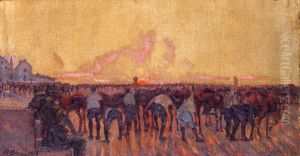Anselmo Bucci Paintings
Anselmo Bucci was an Italian artist known for his work as a painter, engraver, and illustrator. Born on August 25, 1887, in Fossombrone, Italy, he was a prominent figure in the Italian divisionist movement, which was an Italian variant of neo-impressionism.
Bucci's early education was at the Brera Academy in Milan, where he studied under the tutelage of Cesare Tallone. His initial work was influenced by Symbolism, but he gradually shifted towards Divisionism, a style characterized by the separation of colors into individual dots or patches which interacted optically.
During World War I, Bucci served in the Italian army, and his experiences on the front lines profoundly impacted his art. He created a series of war prints that depicted the harsh realities of life in the trenches, which are considered some of his most important works. These prints were later published in the portfolio 'La Guerra Bianca', which received critical acclaim for its raw and emotive power.
After the war, Bucci travelled extensively, spending time in Paris where he was influenced by the modernist movements of the time. He became friends with other Italian artists like Umberto Boccioni and Ardengo Soffici, with whom he shared an interest in Futurism and its dynamic representation of movement and technology. However, Bucci never fully embraced Futurism, preferring to maintain his divisionist approach.
Throughout the 1920s and 1930s, he continued to exhibit his work, including participating in the Venice Biennale. His paintings from this period often depicted urban scenes, landscapes, and seascapes, with a focus on light and color. In addition to painting, Bucci was an accomplished illustrator and contributed to various Italian literary magazines.
Bucci's later years saw him grappling with personal loss and the devastation of World War II. Despite these challenges, he continued to produce art that reflected his dedication to exploring the interplay of light and form.
Anselmo Bucci died on November 19, 1955, in Monza, Italy. His legacy includes not only his contributions to Italian Divisionism but also his ability to capture the human condition through both his war prints and his more tranquil depictions of everyday life. His works remain an important part of Italian art history and are displayed in various museums and galleries throughout the country.
